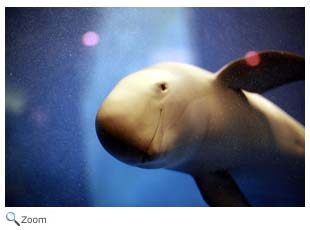Phocoenidae - porpoises
 There are six species in this family. Porpoises are found in all the oceans and often are found in rivers, estuaries, and bays. There are six species in this family. Porpoises are found in all the oceans and often are found in rivers, estuaries, and bays.
Popoises are 4-7 feet in length and weigh around 250 pounds. Porpoises don't have beaks line dolphins; they have rounded snouts. They have narrow flippers, and a triangular dorsal fin. One species, the finless porpoise, has no dorsal fin. Porpoises have spade-shaped teeth and eat fish, squid, and crustaceans.
Porpoises have a blow hole and use echolocation to navigate and locate prey.
World Status Key
 Least Concern Least Concern  Near Threatened Near Threatened  Vulnerable Vulnerable  Endangered Endangered  Critically Endangered Critically Endangered  Extinct in Wild Extinct in Wild  Extinct Extinct
Status and range is taken from ICUN Redlist. If no status is listed, there is not enough data to establish status.
US Status Key
 Threatened in US Threatened in US  Threatened in NH Threatened in NH  Endangered in US Endangered in US  Endangered in NH Endangered in NH  Introduced Introduced
Status taken from US Fish and Wildlife and NH Fish and Game
New Hampshire Species |
|
North/Central American Species |
Harbor Porpoise - Phocoena phocoena 
|
|
Vaquita - Phocoena sinus 
Dall's Porpoise - Phocoenoides dalli  |
Additional Information Resource Key
 Profile Profile  Photos Photos  Video Video  Audio Audio  Interactive Interactive
Burmeister's Porpoise - Phocoena spinipinnis     
Burmeister's porpoise is found in shallow, coastal waters of South America from southern Brazil south to Cape Horn in Tierra del Fuego and north to northern Peru.
Source: Convention on Migratory Species Intended Audience: General Reading Level: High School
Dall's Porpoise - Phocoenoides dalli      
Dall's porpoise is found in the northern Pacific Ocean.
Source: Arkive Intended Audience: General Reading Level: Middle School
Dall's Porpoise - Phocoenoides dalli      
Dall's porpoises are considered the fastest swimmers among small cetaceans. They are capable of reaching speeds of 34 miles per hour.
Source: NOAA Fisheries Intended Audience: General Reading Level: Middle School
Dall's Porpoise - Phocoenoides dalli      
Dall's porpoise has a small, rounded head.
Source: American Cetacean Society Intended Audience: General Reading Level: Middle School
Dall's Porpoise - Phocoenoides dalli       
Dall's porpoise creates a distinct ‘rooster-tail’ splash when it is traveling quickly.
Source: Wild Whales Intended Audience: General Reading Level: Middle School
Dall's Porpoise - Phocoenoides dalli      
Dall's porpoise is black with white flanks. It is also known as the white-flanked porpoise.
Source: Enchanted Learning Intended Audience: Students Reading Level: Elementary School
Dall's Porpoise - Phocoenoides dalli     
Dall's porpoise is about six feet in length.
Source: Animal Diversity Web Intended Audience: General Reading Level: Middle School
Finless Porpoise - Neophocaena phocaenoides       
The finless porpoise is found along the coasts of southern and eastern Asia, from the Arabian Gulf, east to Japan and south to Java, Indonesia.
Source: Arkive Intended Audience: General Reading Level: Middle School
Finless Porpoise - Neophocaena phocaenoides      
The finless porpoise is an inshore species. It is found in both in salt and fresh water.
Source: Convention on Migratory Species Intended Audience: General Reading Level: High School
Finless Porpoise - Neophocaena phocaenoides     
The finless porpoise has no dorsal fin.
Source: Animal Diversity Web Intended Audience: General Reading Level: Middle School
Harbor Porpoise - Phocoena phocoena          
The harbor porpoise is found in cold temperate to sub-polar waters of the Northern Hemisphere.
Source: Arkive Intended Audience: General Reading Level: Middle School
Harbor Porpoise - Phocoena phocoena            
The harbor porpoise is found in shallow coastal waters.
Source: American Cetacean Society Intended Audience: General Reading Level: Middle School
Harbor Porpoise - Phocoena phocoena             
The harbor porpoise usually travels alone or in small groups of up to three individuals.
Source: Wild Whales Intended Audience: General Reading Level: Middle School
Harbor Porpoise - Phocoena phocoena             
During the Middle Ages, harbor porpoise meat was considered a delicacy.
Source: National Geographic Intended Audience: General Reading Level: Middle School
Harbor Porpoise - Phocoena phocoena            
When surfacing for air, harbor porpoises do not splash; they roll from beak to fluke and arch their backs.
Source: NOAA Fisheries Intended Audience: General Reading Level: Middle School
Spectacled Porpoise - Phocoena dioptrica        
The spectacled porpoise is found in the Atlantic from the eastern coast of South America as far as southern Brazil and in the Pacific Ocean as far north as Tasmania and New Zealand.
Source: Arkive Intended Audience: General Reading Level: Middle School
Spectacled Porpoise - Phocoena dioptrica        
The spectacled porpoise is black with white undersides.
Source: Convention on Migratory Species Intended Audience: General Reading Level: High School
Spectacled Porpoise - Phocoena dioptrica        
The spectacled porpoise is 4.25 to 7.25 ft in length.
Source: Enchanted Learning Intended Audience: Students Reading Level: Elementary School
Vaquita - Phocoena sinus     
The vaquita is found in upper Gulf of California, Mexico.
Source: Arkive Intended Audience: General Reading Level: Middle School
Vaquita - Phocoena sinus     
There are only 400 to 600 vaquita in the wild.
Source: Defenders of Wildlife Intended Audience: General Reading Level: Middle School
Vaquita - Phocoena sinus     
The vaquita is the smallest living cetacean.
Source: World Wildlife Fund Intended Audience: General Reading Level: Middle School Vaquita - Phocoena sinus      
The vaquita has a black ring around each eye, a stripe from chin to flipper, and a black lipped-smile.
Source: Vaquita: Last Chance for the Desert Porpoise Intended Audience: General Reading Level: Middle School |

